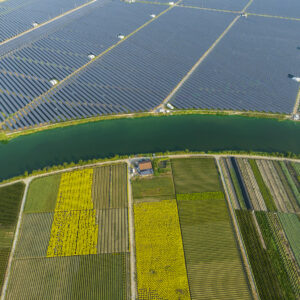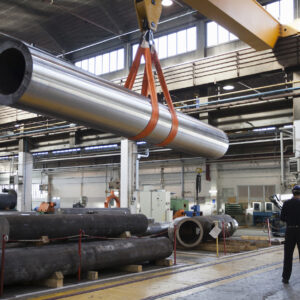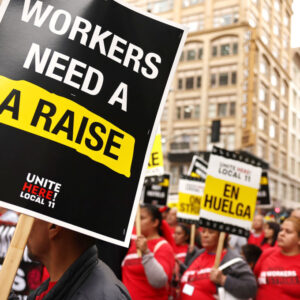Finance as a Tool of Industrial Policy: A Taxonomy of Institutional Options
February 12, 2024
By Saule T. Omarova

"Finance—which encompasses financial tools, practices, markets, and institutions—is not simply one of many commonly used industrial policy levers. It is a critical interface between the state and the economy that the state is trying to reinvigorate or redirect."
Introduction: Why Financial Institutions Matter
Industrial policy is on the rise, but it has yet to evolve into the kind of financial statecraft needed to meet today’s challenges. In industrial policy discussions, finance is habitually lumped together with other types of government subsidies, tax credits, and trade and regulatory policies (Criscuolo et al. 2022). The tools of financing industrial policy are typically limited to government grants, loans, loan guarantees, and various forms of financial risk-sharing through public-private partnerships (PPPs) or similar structures. These financial instruments are used primarily to lower the cost of capital for targeted private business firms seeking to enable private production of the desired goods or services on the desired scale.
This approach paints an incomplete picture of the role finance plays in the design and implementation of industrial policy. Finance—which encompasses financial tools, practices, markets, and institutions—is not simply one of many commonly used industrial policy levers. It is a critical interface between the state and the economy that the state is trying to reinvigorate or redirect. Finance is a direct transmission mechanism of the state’s industrial policy, which fundamentally shapes the context within which all other industrial policy tools operate. The financial market is not simply a back-office infrastructure for the mechanical execution of economic decisions made by nonfinancial actors; it is a powerful driver shaping many of those decisions in today’s heavily financialized economy.
Furthermore, to harness the full potential of finance as a lever of industrial policy, it is essential to focus on the institutional forms through which the state can act as a direct financial market player. The amounts of money spent or allocated to industrial policy goals, or the form in which the money is disbursed (grants, loans, guarantees, etc.) is only part of the picture. Just as important is the institutional channel through which the money flows: It determines how the actual allocation decisions are made, by whom, under what constraints and in response to what factors, and with what ultimate result. Institutions in charge of financing industrial policy critically shape the implementation process and the ultimate economy-wide impact of the government’s programs.
Designing a special-purpose institution that can act as an effective financier of the state’s industrial policy is, therefore, a central component of the overall design and execution of a successful industrial policy. It is a far more optimal approach than relying on the existing general-purpose government agencies using generic fiscal policy tools subject to traditional political and budgetary constraints. A dedicated institution can be designed to have more flexibility, both financially and administratively, to target particular capital needs, and to tailor the conditions under which public resources are deployed for specific purposes.
This essay offers a basic taxonomy of financial institutions productively employed as instrumentalities of developmental and industrial policies. It focuses on three main institutional categories currently in operation outside the United States: sovereign wealth funds (SWFs), national development banks (NDBs), and state holding companies (SHCs).1 Given the diversity and context-specific features of these entities, it is instructive to examine these phenomena through mini case studies of individual institutions whose success and global recognition make them a standard for their respective institutional forms. Bringing in the United States experience, this essay analyzes the Reconstruction Finance Corporation as an institutional experiment in emergency public finance. It concludes with a few thoughts on how a new US instrumentality of developmental finance—the proposed National Investment Authority (NIA)—could build on the existing institutional types to implement an ambitious industrial policy the US needs today.2
The Sovereign Wealth Fund (SWF) Model: Norway’s Government Pension Fund Global (GPFG)
SWFs are a diverse group of special-purpose, government-owned portfolio investment vehicles that pursue a wide variety of domestic policy objectives, including macroeconomic stabilization, cross-generational wealth preservation, and socioeconomic development (Gelpern 2011; Al-Hassan et al. 2013). Countries as diverse as Norway, China, Kuwait, and Ireland, among many others, have established SWFs using public funds from receipts from exports of natural resources, fiscal or balance-of-payments surpluses, and other sources (Sovereign Wealth Fund Institute n.d.). While their investment strategies differ greatly, SWFs generally aim to preserve and grow the nation’s financial resources by building diversified portfolios of primarily publicly traded, foreign currency denominated securities. The fact that SWFs typically have no debt liabilities allows them to take longer investment views and act as suppliers of “patient” capital critical for transformative infrastructure projects (Rose 2016).
One of the world’s largest and most influential SWFs is Norway’s Government Pension Fund Global (GPFG, or the Fund). The GPFG was established in 1969, shortly after the discovery of massive oil reserves in the North Sea, for the dual purposes of managing petroleum revenues and providing for future obligations of the state (Centre for Public Impact 2019). As of December 2022, the Fund held over $1.27 trillion in assets—or about $231,000 per Norwegian citizen (Norges Bank Investment Management 2019).3
Technically, the GPFG is a deposit account at Norges Bank, Norway’s central bank, into which the Ministry of Finance (MoF) transfers Norway’s petroleum income. As the official owner of the account, MoF is responsible for adopting general guidelines for the Fund’s management to be implemented by Norges Bank’s Executive Board—which delegates fund operation to its specialized unit, Norges Bank Investment Management (NBIM). The GPFG is subject to independent audits, complies with extensive public disclosure requirements, and regularly reports to the legislature.4
The GPFG is one of the few large SWFs owned by a democratic government, and is currently the single largest owner in the world’s stock markets, with its equity holdings representing over 1.5 percent of total ownership in all of the world’s publicly listed companies. The Fund’s investments are concentrated in foreign equities, fixed income, real estate, and renewable energy infrastructure. As a large shareholder, the GPFG openly seeks to influence its portfolio companies’ business decisions by directly exercising its corporate management rights, as well as by limiting or prohibiting investment in individual companies on ethical grounds (Halvorssen and Eldredge 2013). This activism is part of the Fund’s mandate: Norges Bank’s Executive Board requires NBIM to “seek to influence companies in its role as a financially motivated shareholder . . . in accordance with the management mandate for the Fund” (Norges Bank Investment Management 2023d). The MoF expressly instructs Norges Bank that “a good long-term return is considered to depend on sustainable economic, environmental and social development, as well as on well-functioning, legitimate and efficient markets” (Norges Bank Investment Management 2023c).5 The MoF also prohibits the GPFG from investing in foreign companies that commit serious violations of human rights, promote war and conflict, cause severe environmental damage, foster corruption, or otherwise violate fundamental ethical norms. A special Council of Ethics, consisting of five outside experts appointed for fixed terms, advises the MoF and continuously monitors the Fund’s portfolio for specific investments inconsistent with ethical guidelines. Upon recommendation from the Council of Ethics or the MoF, Norges Bank can block specific companies from inclusion in the Fund’s portfolio (Norges Bank Investment Management 2023a; Halvorssen and Eldredge 2013; Norges Bank Investment Management n.d.).
The GPFG has long invited criticism as “a template for substantially transparent but politically instrumental funds that also seek to maximize wealth” (Backer 2015). The primary reason for these criticisms is the perception of the Fund as an instrument of extraterritorial exercise of political power through private market means.17
From the perspective of industrial policy capabilities, however, Norway’s experience is valuable precisely because it demonstrates the potential of a SWF structure to serve as an institutional tool for changing economic incentives and behavior of multiple private companies in multiple sectors. Yet, SWFs operate on the cusp of market and politics in a very particular way. Because they do not borrow in private capital markets, their capacity to make mission-driven investments is not constrained by private bondholders’ demands.
That makes them uniquely potent vehicles for implementing democratically established economic priorities. Their greatest strength lies in the scale and scope of their investment portfolios: The bigger a shareholder an SWF is, the more power it can exert on the behavior of a wider range of companies. Importantly, SWFs exercise their influence directly inside the companies, through well-established corporate governance rights. At the same time, however, their core function as a conduit for profitably investing the state’s surplus revenues, usually by holding foreign companies’ securities, limits their flexibility to use that capital for supporting domestic industrial policy goals not aligned with that mandate.6
The National Development Bank (NDB) Model: Germany’s Kreditanstalt Für Wiederaufbau (KfW)
Development banks are another category of public investment institutions widely used for purposes of financing industrial policy objectives (Griffith-Jones et al. 2022; Mertens, Thiemann, and Volberding 2021; Griffith-Jones et al. 2018). Hundreds of multinational, national, and subnational public development banks currently operate in multiple countries around the world (Institute of New Structural Economics n.d.). That list includes entities as varied as the European Investment Bank, Asian Development Bank, Brazil’s Development Bank (BNDES), Canada Infrastructure Bank, and China Development Bank. National development banks, or NDBs, differ from SWFs in their explicitly domestic focus, more diverse sources of funding, and greater flexibility of their investment strategies. Unlike SWFs, NDBs are predominantly credit institutions. Depending on their individual mandates, NDBs invest in the construction of traditional physical infrastructures, agricultural development, social housing, strategic export industries, and other areas prioritized by their governments (Finance in Common 2022).
One of the most successful contemporary examples of the NDB model is Germany’s Kreditanstalt für Wiederaufbau (KfW). Established in 1948, the KfW was initially tasked with distributing and lending funds appropriated to Germany under the Marshall Plan. It is owned jointly by the German federal government (80 percent) and the German states (20 percent), and its activities are directly linked to its two shareholders’ public policy objectives and political priorities (KfW 2022; Marois 2021a). KfW is directly supervised by the Federal Ministry of Finance, together with the Federal Ministry for Economic Affairs and Energy. Two primary governance bodies oversee the KfW’s operations: (1) the Executive Board that manages the bank’s day-to-day operations and comprises members appointed for fixed terms, based on their expertise; and (2) the 37-member Board of Supervisory Directors that exercises overall strategic oversight of KfW’s business affairs (KfW 2022).
Under the KfW Law, the Federal Republic of Germany guarantees all existing and future obligations of KfW and any obligations of third parties expressly guaranteed by KfW (KfW 2020). Because of the government backing, KfW enjoys a very strong credit rating and derives the bulk of its funding from global capital markets. By issuing federally guaranteed bonds, KfW channels large volumes of money into its domestic and global policy-driven lending and investment activities (Naqvi, Henow, and Chang 2018).
Today, KfW is one of the largest publicly owned banks in the world. As of the end of 2022, the KfW had total assets of nearly €555 billion. The KfW Law obligates it to provide financing for a wide variety of government policies. The KfW Group accordingly operates through multiple subsidiaries with separate portfolios. Generally, KfW’s credit portfolio includes loans to small and medium-sized enterprises (SMEs) that constitute the backbone of the German economy, housing-related loans, educational grants, financing for infrastructure projects, and an array of global funding instruments intended to support Germany’s global developmental objectives. The vast majority of KfW’s loans are extended through, and in partnership with, Germany’s public and private commercial banks.7 In that sense, KfW acts as a “banks’ bank,” using its “as good as gold” credit to augment the flow of private credit throughout the economy (Marois 2021b). In addition to running a large portfolio of credit assets, KfW makes strategic equity investments in various sectors and regions. These long-term investments are meant to provide the federal government with the means of taking higher financial risks to promote industrialization, sustainability, and other public policy goals. Notably, one of KfW’s specialized subsidiaries, KfW Capital, invests in German and European venture capital funds, for the purpose of strengthening the growth of start-up businesses (KfW 2022).
This combination of legal mandate and other institutional design features makes the KfW a potent tool of Germany’s industrial policy. In the 75 years of its existence, KfW has evolved into a formidable public institution, firmly embedded in the global financial market and actively directing capital flows into the regions and sectors prioritized by the government. KfW’s market-actor capabilities were on full display during the COVID-19 pandemic and subsequent period. In response to the pandemic, the German government tasked the KfW with expanding its credit offerings and guarantees for all sizes of firms, credit insurers, and nonprofit institutions. In the first half of 2020 alone, KfW’s financing more than doubled in volume as a result of the public financial assistance programs (Marois 2021b, 156-157). In 2022, KfW was at the forefront of Germany’s efforts to manage the economic impact of the invasion of Ukraine and ensuing volatility in energy prices. Actively utilizing its financial resources, KfW “achieved its historically strongest promotional year” in 2022, when its policy-driven business rose by 56 percent due to financing government’s efforts to secure the energy supply in Germany (KfW 2022).
Outside of emergency situations, KfW is increasingly focused on Germany’s long-term sustainability and energy sufficiency policies. KfW actively supports the German government’s ambitious plans to combat climate change, aiming for carbon neutrality by 2050 (Mazzucato and Rodrik 2023). A recent study, for example, details KfW’s financing of the Energy Efficient Refurbishment and Construction Programs aimed at transferring all residential and business buildings to new energy-efficient standards (Mazzucato and Rodrik 2023). To support this large-scale retrofitting and construction campaign, KfW rolled out massive grant and loan facilities that use attractive interest rates, flexible repayment terms, and partial debt relief to incentivize private-sector adoption of the highest environmental standards. These efforts have generated three times as much total investment in these improvements as KfW’s commitments. It is projected to generate aggregate returns to the federal government of as much as €4 per every €1 of budget allocation to the Energy Efficient Refurbishment and Construction Program (Mazzucato and Rodrik 2023).
In sum, KfW exemplifies the potential of a well-designed and ambitious NDB to deliver tangible long-term economic and political results. It highlights the core strengths of the NDB model: the possibility of a broader and more ambitious developmental (as opposed to reserve management) mandate, ability to access private financing in capital markets, and potential diversity of investment tools to advance various policy goals. A typical NDB acts primarily as a lender but can also be an equity investor, so it can use its influence in both roles to direct private-sector behavior and amplify the flow of private capital toward publicly beneficial projects.
To maximize these benefits, however, certain baseline conditions need to exist. The scope and nature of the NDB’s mandate determine the scope and scale of its operations and, therefore, must be formulated in a way that preserves the NDB’s flexibility and ability to achieve multiple public policy goals. The government’s full faith and credit backing is critical to the NDB’s ability to access global capital markets, but it puts the government at risk of financial loss—and potentially the loss of political credibility. This increases the importance of a clear legal and institutional framework for the government’s support and democratic oversight of the NDB’s operations. Yet, government incumbents should not infringe upon the NDB’s operational autonomy nor restrain its transformative potential for political reasons. Heavy reliance on private bond financing can also significantly constrain NDB’s ability to promote the goals of industrial policy by financing projects unlikely to generate commercial revenues necessary to cover the NDB’s debt service payments.
Generally, it is important to remember that the historical, political, and economic context in which an individual NDB operates fundamentally shapes its business choices and its chances of success. The KfW’s experience may not be easily replicable in other contexts, where the state’s legitimacy as an economic market actor is not as effectively embedded in the existing institutional arrangements. Moreover, in the absence of a vast and well-established ecosystem of public banks operating on state and local levels, as is the case in Germany, legally mandating an “on-lending” (or similar private-public partnering) model increases the risk that an NDB would lose control of the capital allocation process and misallocate public funds to the disproportionate benefit of private interests (Schmidt, Bülbül, and Schüwer 2014). This example underscores the need to contextualize individual institutional design features of successful NDBs.
The State Holding Company (SHC) Model: Singapore’s Temasek
SHCs constitute the third major category in the taxonomy of existing institutions of industrial policy. While an SHC can be seen as simply another form of state-owned enterprise—an unfortunately ideologically laden label—it can also be designed as a public asset manager, a public interest-oriented counterpart to private asset managers. In this capacity, an SHC can be utilized for the purposes of industrial policy in a much more direct and assertive way than either an NDB or a SWF model would typically allow.
Singapore’s Temasek Holdings Ltd. is an example of a modern-day SHC operating along the lines of a public portfolio manager and a venture capital firm. Temasek was incorporated in 1974 to manage Singapore’s public funds on behalf of the Ministry for Finance (MFF), its sole shareholder.8 In 1991, the government designated Temasek as a “Fifth Schedule entity” allowed to draw from the government’s reserves (Temasek 2023a).9 Together with the Monetary Authority of Singapore (MAS) and the Government of Singapore Investment Corp (GIC), Temasek supports Singapore’s annual budget by allowing the government to spend up to 50 percent of its expected net investment returns each year.10
Temasek’s charter describes it as “an active shareholder and investor,” “a forward looking institution,” and “a trusted steward” of Singapore’s public funds (Temasek n.d.). Its primary objective is to “build a resilient portfolio that delivers sustainable returns over the long term” (Temasek n.d.) In its earlier years, Temasek’s equity stakes were heavily centered on Singapore’s strategic growth sectors: telecommunications, shipping, and banking. As the nation’s economic priorities evolved, so did Temasek’s. Today, Temasek’s investment activities are focused on long-run structural trends in national and global economies, including digitization and sustainability.11
Temasek is an active investor in domestic and foreign equities. Its portfolio—which stood at S$382 billion as of March 31, 2023—includes a variety of publicly traded securities and (increasingly) unlisted shares, held directly or through investment funds.12 Temasek also forms and manages investment funds, joint ventures, and partnerships. For example, in 2021, Temasek partnered with BlackRock to form Decarbonization Partners, a platform for launching late-stage venture capital funds and early growth private equity funds focused on advancing efforts to achieve a net-zero economy by 2050. At portfolio level, Temasek exercises full discretion to rebalance its holdings dynamically, without a precommitment to any specific sector or asset class. Its emphasis is on being an active portfolio manager, nimbly positioning itself for the maximum return over the long horizon. Nonetheless, Temasek—which was initially capitalized by the Singaporean government transferring shares of 35 government-controlled domestic companies to it—holds controlling equity stakes in Singapore’s sectoral champions, including Development Bank of Singapore and Singapore Airlines. As of March 31, 2023, 54 percent of Temasek’s holdings were in Singapore-headquartered companies (Temasek 2023a; Temasek n.d. b; Temasek 2021; Temasek 2023b).
Temasek finances its activities primarily through portfolio revenues, debt issuances, short-term bank borrowings, and borrowings from the MFF. Temasek’s strong credit rating enables it to issue long-term bonds and commercial paper instruments.13 Importantly, the company uses part of its revenues to finance a wide variety of social services and provide public goods to communities.14 This function was especially significant during the COVID-19 pandemic, when Temasek’s social funds were mobilized to implement the government’s wide-ranging response measures (Temasek Foundation 2023).
As a single-shareholder entity, Temasek is lightly regulated and is subject to limited public disclosure requirements (Chen 2016). As a Fifth Schedule company with the right to draw upon Singapore’s reserves, however, Temasek is subject to other forms of mandatory public oversight. For instance, Temasek’s Board of Directors is accountable to the Singapore president and the parliament, and the president’s approval is required for the appointment, reappointment, or removal of any board members.15 Temasek is also required to provide regular financial reports to the president who has the authority to disapprove its budget.16 Nevertheless, Temasek strongly emphasizes its independence from the government and the fact that it is a “commercial investment company” operating under the guidance of its board, with neither the country’s president nor the MFF being involved in its management or investment decisions (Temasek n.d.). There are also signs suggesting official efforts to bolster a perception of Temasek’s independence from the Singaporean government (Venkat and Paris 2009; Lim and Chatterjee 2009).
In sum, as Temasek’s example shows, the SHC model supports a wide range of direct and flexible institutional channels for the state’s pursuit of active industrial policies. Unlike NDBs, these entities are not focused primarily on lending but can build predominantly equity holdings, which gives them more effective ways of influencing their portfolio companies’ business strategies. In contrast to SWFs, SHCs can take controlling stakes in private companies, which is especially important for nurturing innovative early-stage businesses and facilitating commercialization of new technologies. If that is a significant element of the government’s developmental strategy, having an SHC to act as a venture capital fund greatly enhances its implementation capabilities.
Furthermore, exercising corporate control over strategically important domestic companies allows the government not only to continuously shape the structure of the economy or maintain its geopolitical viability but also to respond more effectively and quickly to any emerging macro-level pressure or emergency. The flexibility of an SHC’s investment tools and mandate allows it to adapt dynamically to the needs of the economy or the state managing it.
That flexibility, however, is also a source of potential vulnerability of the SHC form to political criticism and attacks on its legitimacy. This is a particularly weighty concern in a democratic polity. The intimate connection between the state and the SHC it controls heightens the need for an effective governance and democratic accountability structure that would preserve this entity’s decisional autonomy and ability to pursue public objectives through market means.17
The US “Emergency Public Finance” Experiment: The Reconstruction Finance Corporation
Although the US has no dedicated federal institution tasked with financing or implementing industrial policy, it is a home to one of the most interesting and instructive historical experiments in this area: the Reconstruction Finance Corporation (RFC). During its years of activity (1932–1953), the RFC has achieved remarkable success in mobilizing America’s financial resources to lead the nation through the Great Depression and the World War II effort. The RFC offers an example of what can be termed an emergency public finance option: functionally, a hybrid of NDB and SHC models, with a limited term but significantly broader operational flexibility.
The RFC was established as a special government corporation in the wake of the 1929 stock market crash.18 It marked a unique effort by the US government to intervene directly in a troubled economy to restore public confidence in the nation’s financial system. The RFC was meant to restart the flow of credit necessary to prevent the nation’s economy from collapse by lending to banks, trust companies, and other financial institutions. Congress later authorized the RFC to purchase preferred stock in banks, insurance companies, and other lenders. The RFC was also granted authority to make loans to business enterprises and assist in financing the construction of public works. Under its expanded mandate, the RFC engaged in large-scale direct lending to municipalities, utilities, commercial businesses, farmers and farm co-ops, production credit associations, joint-stock land banks, livestock credit corporations, and local lending institutions. Operating through multiple specialized finance subsidiaries and 33 regional offices nationwide, the RFC became the New Deal’s “capital bank.” During World War II, the RFC took the lead in financing and implementing national defense programs, which included constructing, owning, and operating defense-related manufacturing facilities. To this end, the RFC established eight subsidiary corporations to produce strategic defense goods (Secretary of the Treasury 1959; Wheelock et al. 2013; Olson 1988, 42-46; Bossie and Mason 2020).
The RFC was initially capitalized by selling $500 million in stock to the US Treasury. It was also authorized to borrow from the Treasury. Over time, the RFC borrowed a total of $51.3 billion from the Treasury and $3.1 billion from the public, all backed by the full faith and credit of the US. The RFC typically invested in projects that provided a reasonable assurance of repayment, so that its investment income generally exceeded its losses and expenses. In that sense, it was a commercially sound enterprise. However, many of the RFC’s loans and investments were made with little to no expectation of recovery. Notable examples included grants and loans to other federal government and state agencies during the New Deal era and expenditures in support of the WWII effort. In these cases, Congress “recognized the unbusinesslike nature of these expenditures” and canceled the RFC’s obligations to repay the funds to the Treasury. As the Treasury’s final report on the RFC emphasized, “Nowhere in the basic RFC legislation are there any indications that RFC was established for the purpose of making a profit. The stated purposes for RFC’s existence were to deal with emergency situations and to aid in attaining broad economic goals” (Secretary of the Treasury 1959).
The extraordinary scale of the RFC’s operations and the high degree of flexibility in structuring its investment portfolio were critical determinants of both its commercial success and its extraordinary efficacy as a tool of industrial policy. At its peak, the RFC’s balance sheet dwarfed the combined balance sheets of Wall Street banks (Olson 1988, 20). The RFC’s authority to make equity investments, in particular, augmented its policy-based market footprint. By 1934, the RFC held voting rights in thousands of American firms and was the single largest investor in the country (Olson 1988, 124). It often operated by purchasing as much preferred stock as there was common stock outstanding, thereby doubling the firm’s capital and acquiring a controlling interest. To protect its investment from insider misappropriation or abuse, the RFC actively exercised its shareholder and creditor rights to influence portfolio companies’ dividend and executive compensation policies (Olson 1988, 112, 125–126; Jones and Angly 1975, 156–158). In that sense, it was acting much like a public venture capitalist.
The RFC was terminated by Congress in 1951 but continued operating until 1957, when its assets were transferred to other federal agencies (Butkiewicz 2002).19 While unique in many respects, its experience shows both the need for and the viability of a distinctly American institutional model for implementing a large-scale industrial policy program. We’ve done it before; we can do it again—but better.
Conclusion: Institutional Design Lessons for Financing US Industrial Policy
The choice of the institutional form optimally suited for delivering the desired macroeconomic and sociopolitical results is an essential component of a viable industrial policy. This essay has offered a taxonomy of the key types of national financial institutions that currently perform—or have historically performed—this function. Understanding their distinctive features provides the basis for designing a more finely tuned institutional instrument for the type of industrial policy the United States needs to address multiple challenges it faces today.
These challenges demand a more robust and flexible institutional approach than what even the best-known existing models—Norway’s GPFG, Germany’s KfW, and Singapore’s Temasek—can offer. As this essay shows, each of these examples reflects a unique set of economic, political, cultural, and other circumstances that enabled them to rise to their current prominence. Their success cannot, and need not, be replicated through a wholesale institutional form adoption. Instead, US policymakers should focus on the more granular design choices with respect to financing the new public institution, defining its investment priorities and powers, and ensuring its democratic accountability.
The proposal to establish a National Investment Authority (NIA) takes such a modular approach to institutional design (Omarova 2022). It builds on certain key elements of the NDB and the SHC models, combined with the RFC’s intense focus on the political-economy aspects of its mission.
The NIA is envisioned as a dedicated institutional platform for operationalizing, financing, and implementing nationwide developmental and industrial policy initiatives. Its proposed structure allows for a coordinated public action in multiple markets through multiple channels. The NIA Governing Board, an independent federal agency subject to democratic control by Congress and the president, would oversee and strategically direct several operating entities—federally chartered government corporations—managing large, diversified portfolios of investments (Omarova 2022). One operating NIA subsidiary, the National Infrastructure Bank (NIB), would focus on credit-based financing of industrial policy priorities through loans, guarantees, securitization, and secondary market-making (Omarova 2022). It would function as a modified version of an NDB, with a broader set of tools applied at a deliberately large scale.
A separate NIA subsidiary, the National Capital Management Corporation (NCMC, or “Nicky Mac”), would specialize in equity-based finance, mainly of higher-risk structural priorities (Omarova 2022). It would function as a publicly owned asset manager, setting up multiple investment funds and soliciting pension funds, endowments, and other potentially “patient” institutional investors to purchase passive equity stakes as limited partners in its funds.20 As the sole general partner, Nicky Mac would select and manage, with appropriate public input and oversight, individual funds’ portfolios of equity investments in advanced clean technology, critical physical and social infrastructure, and other transformative projects that currently do not get financed on the necessary scale. In effect, Nicky Mac would augment the traditional SHC model’s active investment management capabilities, taking it closer to the RFC’s finest moments as the engine of long-term economic renewal.
Learning from successful NDB and SHC examples, it is critical to maintain the NIA’s ability to self-finance. However, to maximize its operational autonomy from both incumbent politicians and private bondholders, the NIA would have to avoid excessive dependence on explicit federal guarantees and private capital markets. To this end, the Federal Reserve would provide liquidity support for the NIA subsidiaries, much like it does for many public and private entities today. In an emergency, the NIA would also have the right to borrow directly from the Treasury. This form of government backup would enable the NIA to pursue long-term industrial policy goals without being hampered by demands of “commercial viability” or electoral cycles (Omarova 2022).
Many other design features of the proposed NIA—including its mandate, functions, governance, and accountability mechanisms—creatively adapt and build on the cumulative experience of other public investment institutions, at home and abroad. For purposes of this essay, the key is simply to highlight the general direction in which we can take the project of building a new institution for financing America’s new industrial policy. As this brief sketch of the NIA idea shows, we can approach this task thoughtfully but boldly, so that the result is both historically rooted and decisively forward-looking.
___
The author would like to thank Zachary Hunt for excellent research assistance, Todd Tucker for his comments, Sunny Malhotra for research assistance, and Sonya Gurwitt and Claire Greilich for their editorial contributions.
Footnotes
Read the footnotes
1This essay focuses on national-level financial institutions, as opposed to multinational or subnational entities. It also excludes traditional government agencies that may disburse appropriated government funds for industrial policy purposes as part of their broader sectoral mandate. The focus here is on specialized institutions of public investment.
2For the full NIA design proposal, see Omarova 2022.
3The government can draw funds from the GPFG, up to a specified limit (Alsweilem et al. 2015).
4The Sorting (Norway’s legislative body) establishes the Fund’s formal framework and assigns responsibility for its implementation to the MoF. The Sorting has to approve any significant change to the Fund’s investment strategy (Norges Bank Investment Management 2019).
5 By 2021, the GFPG had divested its holdings of fossil fuel company assets (Arvin 2021).
6This foreign-domestic division is a direct function of individual SWFs’ mandates. Some SWFs, such as Ireland’s Strategic Investment Fund (ISIF), have an explicit mandate to invest in domestic industries (National Treasury Management Agency n.d.). Financial returns, however, are an essential element of the SWF business model, which again limits their flexibility as a tool of investing in a broader range of domestic public goods.
7The KfW Law expressly mandates this participation approach (KfW 2020).
8Minister for Finance (Incorporation) Act (Cap 183, 2014 Rev Ed), https://sso.agc.gov.sg/Act/MFIA1959; see also Temasek, Temasek Review 2023, Temasek.com (2023), https://www.temasekreview.com.sg/.
9See Temasek Review 2023, A Trusted Steward, https://www.temasekreview.com.sg/stewardship/a-trusted-steward.html; Constitution of the Republic of Singapore, Fifth Schedule (Sing), https://sso.agc.gov.sg/Act/CONS1963?ProvIds=Sc5-#Sc5-.
10MAS is Singapore’s monetary authority; GIC is the principal SWF.
11Toward the latter goal, Temasek claims to “deploy capital to catalyze solutions that enable the transition to a low carbon economy” (Temasek n.d.d).
12In recent years, Temasek has pivoted away from public markets and toward private markets (South China Morning Post 2019).
13As of March 31, 2023, Temasek had S$20.2 billion in outstanding bonds, and S$1.3 billion in Euro-denominated commercial paper (Temasek n.d.c).
14By 2023, the company has committed in total close to S$1 billion to operate its nearly 1,500 social programs that include mental and physical health services, cultural exchange, music and arts educational facilities, care for the elderly, and so forth (Temasek Foundation n.d.).
15Constitution of the Republic of Singapore, §22C (1A) (Sing), https://sso.agc.gov.sg/Act/CONS1963?ProvIds=P15-#pr22C-.
16Constitution of the Republic of Singapore, §22D (1A) (Sing), https://sso.agc.gov.sg/Act/CONS1963?ProvIds=P15-#pr22D-.
17Given the direct state ownership of an SHC (especially if it is organized as a commercial corporation with a single shareholder), this model is likely to face the same political and ideological obstacles as the more general category of a “state-owned enterprise” (SOE), routinely vilified in the mainstream economic literature of the last several decades.
18See Reconstruction Finance Corporation Act, 15 U.S.C. § 601 et seq (repealed 2010) [hereinafter RFC Act].
19The RFC’s surviving offspring include the Federal National Mortgage Association (Fannie Mae), the housing finance giant originally established as the RFC’s mortgage subsidiary, and the Small Business Administration (SBA), which was set up in 1953 to take over the RFC’s small business and disaster relief loans (Butkiewicz 2002).
20To minimize undesirable arbitrage opportunities, Wall Street banks, private equity funds, and hedge funds would not be eligible participants.
References
Read the references
Al-Hassan, Abdullah, Michael G. Papaioannou, Martin Skancke, and Cheng Chih Sung. 2013. “Sovereign Wealth Funds: Aspects of Governance Structures and Investment Management.” Working Paper no. 13/231. IMF Working Paper Series. Washington, DC: International Monetary Fund. https://www.imf.org/external/pubs/ft/wp/2013/wp13231.pdf.
Alsweilem, Khalid A., Angela Cummine, Malan Rietveld, and Katherine Tweediev. 2015. Sovereign Investor Models: Institutions and Policies for Managing Sovereign Wealth. Cambridge, MA: John F. Kennedy School of Government, Center for Science and International Affairs and Center for International Development. https://projects.iq.harvard.edu/sovereignwealth/sovereign-investor-models-institutions-and-policies-managing-sovereign-wealth.
Arvin, Jariel. 2021. “Norway’s Trillion-Dollar Wealth Fund Sold the Last of Its Investments in Fossil Fuel Companies.” Vox, January 29, 2021. https://www.vox.com/22256192/norway-oil-gas-investments-fossil-fuel.
Backer, Larry Catá. 2015. “SWFs in Five Continents and Three Narratives: Similarities and Differences.” In Research Handbook on Sovereign Wealth Funds and International Investment Law, 57–96. Cheltenham, UK: Edward Elgar Publishing. https://www.elgaronline.com/edcollchap/edcoll/9781781955192/9781781955192.00012.xml.
Bossie, Andrew, and J.W. Mason. 2020. “The Public Role in Economic Transformation: Lessons from World War II.” Working Paper. New York: Roosevelt Institute. https://rooseveltinstitute.org/publications/the-public-role-in-economic-transformation-lessons-from-world-war-ii/.
Butkiewicz, James. 2002 “Reconstruction Finance Corporation.” Economic History Association, July 19, 2002. https://eh.net/encyclopedia/reconstruction-finance-corporation/.
Centre for Public Impact. 2019. “The Government Pension Fund Global (GPFG) in Norway.” Centre for Public Impact, September 2, 2019. https://www.centreforpublicimpact.org/case-study/government-pension-fund-global-gpfg-norway.
Chen, Christopher. 2016. “Solving the Puzzle of Corporate Governance of State-Owned Enterprises: The Path of the Temasek Model in Singapore and Lessons for China.” Northwestern Journal of International Law & Business 36, no. 2: 303-370. https://ink.library.smu.edu.sg/sol_research/1693/.
Criscuolo, Chiara, Nicolas Gonne, Kohei Kitazawa, and Guy Lalanne. 2022. “Are Industrial Policy Instruments Effective? A Review of the Evidence in OECD Countries.” OECD Science, Technology and Industry Policy Papers. Paris: OECD. https://doi.org/10.1787/57b3dae2-en.
Finance in Common. 2022. FICS 2022 Progress Report. Paris: Finance in Common. https://financeincommon.org/fics-2022-progress-report.
Gelpern, Anna. 2011. “Sovereignty, Accountability, and the Wealth Fund Governance Conundrum.” Asian Journal of International Law 1, no. 2: 289–320. https://doi.org/10.1017/S2044251310000391.
Griffith-Jones, Stephany, Régis Marodon, Louis-Philippe Rochon, and Jiajun Xu. 2022. Development and Public Banks. Milton Park, Oxfordshire, UK: Taylor & Francis.
Griffith-Jones, Stephany, José Antonio Ocampo, Felipe Rezende, Alfredo Schclarek, and Michael Brei. 2018. The Future of National Development Banks. Oxford, UK: Oxford University Press. https://doi.org/10.1093/oso/9780198827948.003.0001.
Halvorssen, Anita M., and Cody D. Eldredge. 2013. “Investing in Sustainability: Ethics Guidelines and the Norwegian Sovereign Wealth Fund.” Denver Journal of International Law and Policy 42, no. 3: 389. https://digitalcommons.du.edu/cgi/viewcontent.cgi?article=1095&context=djilp.
Institute of New Structural Economics. n.d. “Public Development Banks and Development Financing Institutions Database.” Peking University. Accessed November 15, 2023. http://www.dfidatabase.pku.edu.cn/#:~:text=News,-More&text=Public%20Development%20Banks%20(PDBs)%20and,proactively%20achieve%20public%20policy%20objectives.
Jones, Jesse Holman, and Edward Angly. 1975. Fifty Billion Dollars: My Thirteen Years with the RFC (1932-1945). New York: Macmillan.
Kreditanstalt Für Wiederaufbau (KfW). 2020. “Law Concerning Kreditanstalt für Wiederaufbau.” Mission and Tasks of KfW. Last updated June 2020. https://www.kfw.de/About-KfW/Service/Download-Center/Konzernthemen/Rolle-und-Aufgaben-der-KfW-Bankengruppe/.
______. 2022. “Financial Report.” KfW. 2022. https://www.kfw.de/About-KfW/Service/Download-Center/Financial-Publications/Finanzbericht/.
Lim, Kevin, and Neil Chatterjee. 2009. “Temasek’s Revised Charter Downplays Singapore Links.”. Reuters, August 24, 2009, sec. Media & Telecom. https://www.reuters.com/article/temasek-charter-idUKSGC00326020090825/.
Marois, Thomas. 2021a. “The KfW and COVID-19: Coordinating Public Finance Responses at Home and Abroad.” In Public Banks and COVID-19: Combatting the Pandemic with Public Finance, 149–70. Geneva, Switzerland: United Nations Conference on Trade and Development. https://www.municipalservicesproject.org/sites/municipalservicesproject.org/files/publications/Chapter%207%20-%20KfW.pdf.
______. 2021b. Public Banks: Decarbonisation, Definancialisation and Democratisation. Cambridge, UK: Cambridge University Press.
Mazzucato, Mariana, and Dani Rodrik. 2023. “Industrial Policy with Conditionalities: A Taxonomy and Sample Cases.” Working Paper no. 2023-07. UCL Institute for Innovation and Public Purpose (IIPP) Working Paper Series. London: Institute for Innovation and Public Purpose. https://www.ucl.ac.uk/bartlett/public-purpose/publications/2023/oct/industrial-policy-conditionalities-taxonomy-and-sample-cases.
Mertens, Daniel, Matthias Thiemann, and Peter Volberding. 2021. The Reinvention of Development Banking in the European Union: Industrial Policy in the Single Market and the Emergence of a Field. Oxford, UK: Oxford University Press.
Naqvi, Natalya, Anne Henow, and Ha-Joon Chang. 2018. “Kicking Away the Financial Ladder? German Development Banking under Economic Globalisation.” Review of International Political Economy 25, no. 5: 672–98. https://doi.org/10.1080/09692290.2018.1480515.
National Treasury Management Agency (NTMA). n.d. “Ireland Strategic Investment Fund.” NTMA. Accessed November 15, 2023. https://www.ntma.ie/business-areas/ireland-strategic-investment-fund.
Norges Bank Investment Management. 2019. “Governance Model.” Norges Bank Investment Management. Last updated April 26, 2019. https://www.nbim.no/en/organisation/governance-model/.
______. 2023a. “About Us.” Norges Bank Investment Management. Last updated March 3, 2023. https://www.nbim.no/en/organisation/about-us/.
______. 2023b. “Management Mandate.” Norges Bank Investment Management. Last updated February 27, 2023. https://www.nbim.no/en/organisation/governance-model/management-mandate/.
______. 2023c. “Market Value.” Norges Bank Investment Management. Last updated March 7, 2023. https://www.nbim.no/en/the-fund/Market-Value/.
______. 2023d. “Principles for Responsible Investment Management in Norges Bank.”Last updated February 8, 2023. https://www.nbim.no/en/organisation/governance-model/executive-board-documents/principles-for-responsible-investment-management-in-norges-bank1/.
______. n.d. “Observation and Exclusion of Companies.” Norges Bank Investment Management. Accessed December 1, 2023.https://www.nbim.no/en/responsible-investment/ethical-exclusions/exclusion-of-companies/.
Olson, James S. 1988. Saving Capitalism: The Reconstruction Finance Corporation and the New Deal, 1933-1940. 2017 ed. Princeton, NJ: Princeton University Press. https://press.princeton.edu/books/hardcover/9780691629520/saving-capitalism.
Omarova, Saule T. 2022. “The National Investment Authority: An Institutional Blueprint.” White Paper Berggruen Institute. https://www.berggruen.org/ideas/articles/the-national-investment-authority-a-blueprint/
Rose, Paul. 2016. “Sovereign Fund Selling, Market Volatility and Systemic Risk: Connections and Regulatory Possibilities.” Working Paper no. 357. Ohio State Public Law Working Paper Series. Milan, Italy: Bocconi SWF Investment Lab Annual Report. https://doi.org/10.2139/ssrn.2805437.
Schmidt, Reinhard H., Dilek Bülbül, and Ulrich Schüwer. 2014. “The Persistence of the Three-Pillar Banking System in Germany.” In Alternative Banking and Financial Crisis, edited by Kurt von Mettenheim and Olivier Butzbach, 101–22. London: Pickering & Chatto. https://www.cambridge.org/core/books/alternative-banking-and-financial-crisis/persistence-of-the-threepillar-banking-system-in-germany/70944A349B38DFC00E2C0AB47A28F7D8.
Secretary of the Treasury. 1959. Final Report on the Reconstruction Finance Corporation. Washington, DC: US Department of Treasury. https://fraser.stlouisfed.org/files/docs/publications/rcf/rfc_19590506_finalreport.pdf.
South China Morning Post. 2019. “Volatile Stock Prices Are Driving Singapore’s Temasek to Look at Private Assets, Chief Executive Pillay Says.” South China Morning Post, July 10, 2019. https://www.scmp.com/business/companies/article/3017986/volatile-stock-prices-are-driving-singapores-temasek-look.
Sovereign Wealth Fund Institute (SWFI). n.d. “What Is a Sovereign Wealth Fund?” SWFI. Accessed November 15, 2023. https://www.swfinstitute.org/research/sovereign-wealth-fund.
Temasek. 2021. “Temasek and BlackRock Launch Decarbonization Investment Partnership.” Temasek, April 13, 2021. https://www.temasek.com.sg/en/news-and-resources/news-room/news/2021/temasek-blackrock-launch-decarbonization-partnership.
______. 2023a. “Portfolio Performance.” Temasek. March 31, 2023. https://www.temasek.com.sg/en/our-financials/portfolio-performance.
______. 2023b. “Temasek at a Glance.” Temasek. March 31, 2023. https://www.temasek.com.sg/en/about-us/temasek-at-a-glance.
______. n.d. “Corporate Governance.” Temasek.Com.Sg. Accessed November 17, 2023. https://www.temasek.com.sg/content/temasek-corporate/en/about-us/corporate-governance.
Temasek Review 2023. n.d.a “A Trusted Steward.” Stewardship and Community. Last accessed December 1, 2023. https://www.temasekreview.com.sg/stewardship/a-trusted-steward.html.
______. n.d.b. “Investment Update.” Resilient & Forward Looking Portfolio. Last accessed December 1, 2023. https://www.temasekreview.com.sg/portfolio/investment-update.html.
______. n.d.c. “Temasek Bonds.” Resilient & Forward Looking Portfolio. Last accessed December 1, 2023. https://www.temasekreview.com.sg/portfolio/temasek-bonds.html.
______. n.d.d. “The Temasek Charter.” Overview. Last accessed December 1, 2023. https://www.temasekreview.com.sg/overview/the-temasek-charter.html.
Temasek Foundation. 2023. Temasek Foundation Report 2023. Singapore: Temasek Foundation. https://www.temasekfoundation.org.sg/report2023/Index.html.
______. n.d. “Key Facts.” Temasek Foundation. Accessed November 17, 2023. https://www.temasekfoundation.org.sg/.
Venkat, P.R., and Costas Paris. 2009. “Temasek Steps Back From Singapore Inc.” Wall Street Journal, August 26, 2009. https://www.wsj.com/articles/SB125117657532456163.
Wheelock, David C., Michael Gou, Gary Richardson, Alejandro Komai, and Daniel Park. 2013. “Reconstruction Finance Corporation Act.” Federal Reserve History, November 22, 2013. https://www.federalreservehistory.org/essays/reconstruction-finance-corporation.
Explore the Series
The Role of State Ownership: Overview of State-Owned Entities in the Global Economy
by Kyunghoon Kim
Leading With Industrial Policy: Lessons for Decarbonization from Swedish Green Steel
by Jonas Algers

Just Energy Transition in the Time of Place-Based Industrial Policy: Patch or Pathway to the Green Industrial Transformation?
by Andrea Furnaro
Fair Transition Funds, Employer Neutrality, and Card Checks: How Industrial Policy Could Relaunch Labor Unions in the United States
by César F. Rosado Marzán
Electric Vehicles: How Corporate Guardrails Can Improve Industrial Policy Outcomes
by Lenore Palladino




